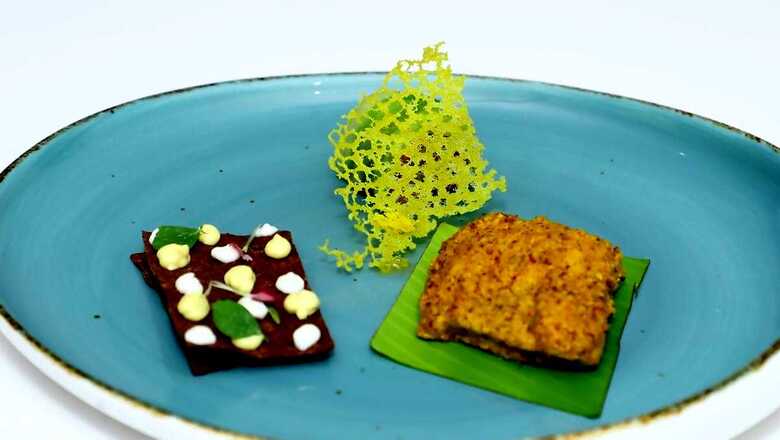
views
I first met Tanya Godrej, the charming and poised executive director of the Godrej Group, at a little sit-down lunch hosted by her at the modern glass and chrome Godrej headquarters at Vikhroli, an hour away from South Mumbai. It was 2018 and the occasion was the launch of the Godrej Food Trends Report.
Sujit Patil, VP and Head of Brand and Communications, was ebullient, buoyant and full of effervescence; after all it was his baby that was going to be born that afternoon. The writer, researcher and creator of this report, Rushina Munshaw Ghidiyal was exhausted, slightly nervous and flitted around explaining food trends that she had so lovingly explored and scrutinised. And while the small group of food lovers and writers earnestly gathered to grasp the nuances of this culinary exegesis, I was very keen to simply discover the menu for lunch. And the lunch was fab.
From the full-fledged five-star kitchen on the executive floor of Godrej One, along with full silver service, came dish after dish of the most delicately curated interpretations of Indian food. Tanya is. after all, the daughter of the late Parmeshwar Godrej, one of India’s classiest hostesses ever, and she lived up to their family’s reputation of being a notch above everyone else when it came to style and hospitality.
On a slightly more serious note, Godrej has since, initiated this Food Trend study year after year, and this report has not only been facilitating deep conversations in the food space each year, but has emerged as one of the most credible oracles of estimates that significantly impact the food industry annually. Of course, the launch of the Godrej Food Trend Report is always preceded with one of Tanya’s glorious lunches, or as it was in this case last week, dinner. But before I drool over the meal, a bit about the what trends we can expect in the food space in the next year. Since this is a report from India, its rich culinary heritage is in focus. On that note, let’s start with a few food trends that are expected to not only impact the food industry, the hospitality industry, but also the way we eat.
Firstly, the report predicts that India will be recognised as an atlas of food. No longer will we be known as the makers of curry, vindaloo and tandoori chicken, a change will happen and that change has already started. The interest in regional cuisines has been growing in the last many years. Even abroad, evolved Indian chefs and restaurants have strived to use global influences with traditional Indian food with some great results. Menus inspired by culinary heritage are expected to grow exponentially.
Secondly, an unusual trend for this year. A renewed interest in Nostalgic Foods. What do I mean by that? I still like to go to the 60-year-old Gaylords at Churchgate in Mumbai, and order a “Chicken-a-la-Kiev”. A dish that is very rare to find. Exactly like that there is expected to be a move towards seeking comfort in nostalgic foods, flavours, and brands. In the kind of food offered by home chefs, on house-party menus. Maybe retro-themes will also inspire restaurant décor, menus and style.
Snacking maybe considered a bad habit, but is a growing trend. Indian cuisine has so many snacks that you can walk into a snack shop and get bewildered. Yet the snack segment is set to explode and the Indian consumer is hungry for new flavours and excitement on the plate. Besides looking for the usual, samosa, patties, chivda, thepla, dhokla, I find myself looking for diet-based snacks and hardly ever find a snack which is good for you, and tastes good as well. Here lies the opportunity.
They call it Pan-Ready; we call it ready-to-eat. Ready-to-eat, from pack to pan, samosas, kababs, tikkis and other snacks, that just need a quick heating will be sought after, and local flavours will play a big role. How many of you have ordered a pack of Poha or Upma on a flight on a plane? The one where you just add hot water and sit pretty for four minutes, only to get a fabulous, hot Indian snack that is tasty and wholesome? That’s the future.
This one is an interesting one. There is expected to be a great interest for sauces and condiments and that demand will grow exponentially. I am guessing that if you have more snacks, and more ready-to-eat food, you will need more chutneys and sauces with the snacks. Seems like that need for sauces, dips, and condiments goes hand in hand with the previous two trends.
There are quite a few more trends but I want to touch upon just a couple of them before I sign off. Health remains top of mind in some way or the other. There is expected to be a resurgence of traditional fats like ghee and butter, be sesame (gingelly) oil, peanut oil, and mustard oil. Also, a renewed interest in protein-rich and probiotic alternatives like yoghurt and whey-based drinks. Even desserts with healthier options will be in demand. Desserts have been heading the healthy way for a while now, sugar-free sweets, sweets with natural sugars, sweets made with dry-fruit and nuts. 2023 is expected to see consumers and diners increasingly gravitating towards mindful, portion-controlled indulgences made with ‘good-for-you’ ingredients like natural sweeteners, millets, and more.
And finally, the big-bang ingredient of the year. Millet. Millets have long been a traditional food in India, but their popularity has declined in recent decades with the rise of rice and wheat as staple crops. At the behest of India, the United Nations General Assembly at its 75th session declared 2023 the International Year of Millets. Traditionally grown and consumed in the Indian subcontinent for over 5,000 years, millets are rich in fibre, protein, vitamins, and minerals, and a nutrient-dense food, loaded with iron, calcium, magnesium, and potassium, completely gluten-free, with a low glycemic index, the millet is my answer to wheat and maida. Give me a bhakri made with ragi, nachni, bajra, or jowar any day.
This year too, “the report” was launched with a fine sit-down meal, in beautifully decorated glass atrium. The in-house chefs had created a menu based on the findings of the report, using traditional ingredients, but stylishly plated and presented. Tanya, Sujit and the teamed beamed as they literally brought a research paper alive on a plate.
Kunal Vijayakar is a food writer based in Mumbai. He tweets @kunalvijayakar and can be followed on Instagram @kunalvijayakar. His YouTube channel is called Khaane Mein Kya Hai. The views expressed in this article are those of the author and do not represent the stand of this publication.
Read all the Latest Lifestyle News here



















Comments
0 comment